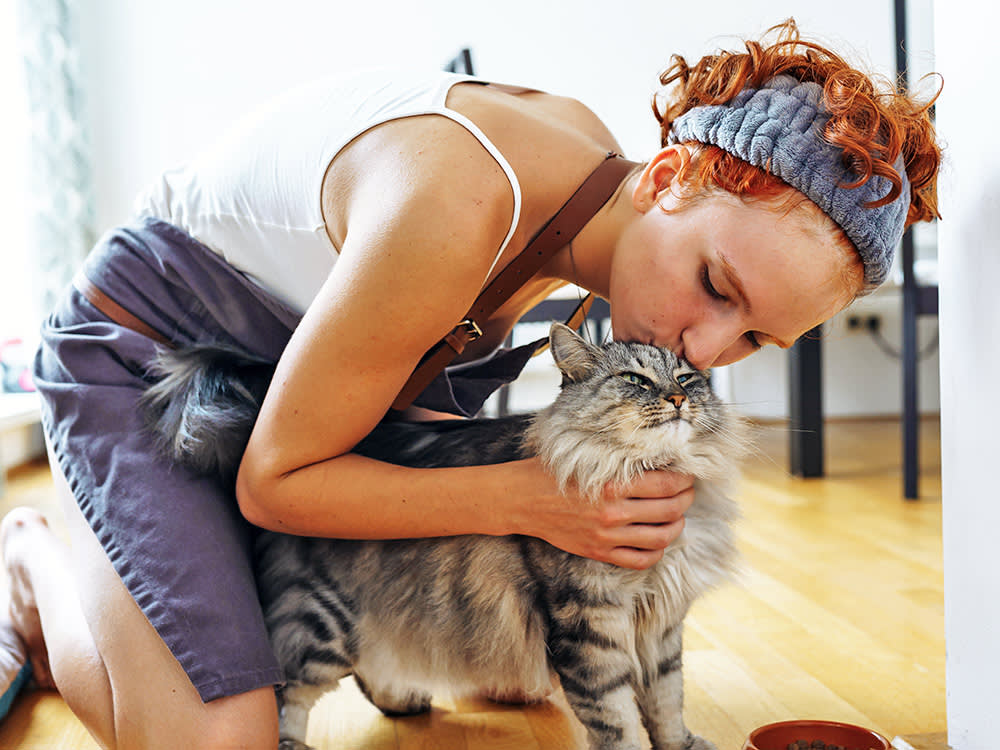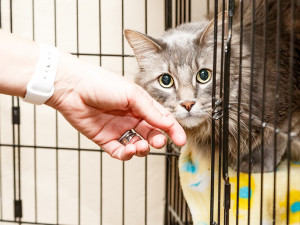How to Temporarily Foster a Cat in the UK
Give the gift of a temporary home to a kitty in need
If you’ve ever wanted to cuddle a cat without committing to a lifetime of litter trays, scratching posts and impromptu 3am zoomies, temporary cat fostering might be the perfect solution. Not only does it give a kitty in need a warm, loving space to land, but it also helps animal charities free up space in shelters and gather more insight about each cat’s personality.
So, if you’re wondering how to get involved, what it actually means to foster or how to make your flat-share feline friendly, read on.
What is temporary cat fostering?
Temporary cat fostering is when you open your home to a cat in need for a short period of time, often while they’re recovering from illness, awaiting adoption or escaping a stressful shelter environment.
You’re basically giving them a mini staycation from the cattery, with added strokes and snacks.
Fostering isn’t forever (unless you fall head over paws in love – it happens), and all major costs such as vet bills and food are usually covered by the charity or rescue centre you’re fostering through.
Benefits of temporary fostering
Temporary cat fostering is a win-win-win situation – for the cat, for animal shelters and for you.
It helps cats get adopted
Fostering gives cats the chance to show off their true personalities in a home environment, which can make a huge difference when they’re being matched with potential adopters. A stressed-out or shy cat in a shelter may come out of their shell completely once they’ve had a bit of peace and quiet (and a comfy windowsill to nap on). Plus, fosterers can provide valuable info about the cat’s behaviour, likes, dislikes and quirks.It frees up space in shelters
UK animal shelters are often at capacity, especially during kitten season (aka spring/summer, when unneutered cats do what unneutered cats do best). By taking in a foster cat, you’re directly helping to create space for another animal in need.It’s a low-commitment way to enjoy animal companionship
Want the cat snuggles but not the 15-year contract? Fostering is perfect for people who can’t commit to full-time pet parenthood, whether that’s because you're renting, frequently travelling or just not quite ready. It gives you all the joy, with built-in flexibility.It’s good for your mental health
Caring for an animal can reduce stress, boost mood and help create structure in your daily routine. Plus, nothing cures a bad day like a purring cat curled up on your lap.You learn loads
From how to care for a senior cat to socialising feral kittens, fostering can teach you loads of practical and emotional skills, especially if you’re considering working with animals in the future.
Which types of cats need temporary fostering?
Temporary cat fostering isn’t just for cats waiting to be adopted, it’s used in a range of situations, and there’s more demand than you might think. Here are some of the cats (and humans) who can benefit:
Cats recovering from illness or surgery
Some cats just need a quiet, calm place to recover from operations or treatment. Foster homes offer the peace and one-on-one care that busy shelters can’t always provide.Cats who struggle in shelters
Some cats – especially older ones, or those who have experienced trauma – find shelters too overwhelming. A foster home helps reduce their stress and gives them time to decompress, which can massively improve their wellbeing.Kittens and pregnant cats
Very young kittens or pregnant cats need extra care, socialisation and often round-the-clock attention, all of which are easier to provide in a foster home. Kittens raised in homes also tend to be better socialised and more confident.Emergency fostering
Some charities, like Cats Protection, provide temporary fostering for pets whose owners are in crisis, for example, those fleeing domestic abuse, experiencing homelessness or undergoing medical treatment. These temporary arrangements keep pets safe and allow owners time to get back on their feet.
In short: fostering helps cats who need more than a kennel can give – and helps people who want to support animals without full-time commitment.
How temporary cat fostering works
You might imagine fostering as simply ‘borrowing a cat’, but there’s a bit more to it – though it’s still very manageable and highly rewarding. Here’s what the process usually looks like:
Step one: application
You apply through an animal rescue or charity. This usually involves a short form about your living situation, experience with pets and availability. Don’t worry if you’ve never had a cat before, many places welcome first-time fosters.
Step two: home check
Most organisations will do a home check, either in person or virtually, to make sure the space is safe and suitable. They’re not judging your interior design choices, just checking for obvious hazards and whether you have the right setup for a cat (eg, somewhere to put a litter tray, quiet sleeping areas, etc).
Step three: matchmaking
Based on your home and preferences (whether you’re home during the day, if you have other pets), the charity will match you with a cat who fits your setup. Some cats may need a super-quiet home, while others are more social and adaptable.
Step four: supplies and settling in
Most charities provide everything you need: food, litter, bowls, a carrier, toys – the lot. You’ll get guidance on helping the cat settle in and who to call if you need anything. Then it’s just a case of offering love, attention and a safe space while they wait for their forever home.
How long can a cat stay in temporary fostering?
There’s no one-size-fits-all answer – some cats might need a week or two, while others could be with you for several months. It all depends on their situation: are they recovering from an op? Waiting for adoption? Coming from a hoarding case? Charities usually work with you to ensure the fostering duration suits your availability and lifestyle.
If you’re going away or need to stop fostering for any reason, just let them know in advance, there’s usually plenty of flexibility.
Finding temporary cat fostering opportunities
There are lots of brilliant organisations across the UK looking for cat fosterers right now. Explore your options below and reach out to them if you have any questions – they’ll be glad to help and answer queries.
RSPCAopens in new tab
The RSPCA operates across England and Wales, and many local branches run fostering programmes for cats (and other animals too). They provide training, support and cover all costs. Apply through your local branch or the national website
Cats Protectionopens in new tab
The UK’s biggest cat charity, with over 200 volunteer-run branches, Cats Protection’s fostering network is essential to their work. They’ll match you with cats, supply everything you need and provide full support along the way.
Blue Crossopens in new tab
This UK-wide charity runs a foster care scheme and is often looking for volunteers. Their system includes training and all necessary supplies.
Battersea Dogs & Cats Homeopens in new tab
With centres in London, Berkshire and Kent, Battersea often places cats into foster homes, especially if they’re recovering from treatment or find the shelter environment stressful.
Mayhewopens in new tab
Based in northwest London, Mayhew offers a fostering programme for cats (and dogs) who need extra TLC before adoption. They work closely with the community, including support for pet owners in crisis.
Woodgreenopens in new tab
Operating in Cambridgeshire and beyond, Woodgreen often needs fosterers for cats and kittens. Their site has a detailed sign-up process and they offer full training.
Local rescues
Don’t forget your local animal rescue charities. Many smaller, independent organisations rely heavily on fosterers. A quick google search or local Facebook group browse can turn up opportunities right in your neighbourhood.
How to become a temporary cat foster
Tempted? Here’s how to get started:
Choose a charity or rescue centre near you.
Apply online or contact them directly – many sites have a short form to fill out.
A home check will happen to make sure it’s a safe space.
Get matched with a cat in need and start fostering!
Most organisations are looking for calm, pet-safe homes. And don’t worry if you’ve never fostered before – enthusiasm and a cat-friendly mindset go a long way.
Responsibilities of a temporary cat foster
You’ll be in charge of day-to-day care including feeding, grooming, playing and providing a stress-free environment. You’ll also monitor their health and behaviour and report back to the rescue centre as requested. You may need to take them to vet appointments but the cost of this should be covered by the rescue centre (and they may help cover the cost of transport if needed).
Don’t worry, you’re not expected to be a vet or cat whisperer. The goal is to give them love, comfort and a little structure.
Support and resources for cat fosters
Fostering can feel a bit daunting at first, but you won’t be doing it alone. Most charities offer:
A dedicated contact for questions or concerns.
Vet care and advice covered.
Supplies like food, toys and litter.
Online or in-person training.
Plus, there’s a whole community of fosters out there. Many organisations run Facebook groups or forums where you can share pics, tips and the occasional “my foster cat just knocked a plant off the windowsill again” moment.
The bottom line: temporary cat fostering
Temporary cat fostering in the UK offers a flexible, rewarding way to help cats in need, whether they’re recovering from illness, struggling in shelters or awaiting adoption. It benefits animals, charities and fosterers alike, with support, supplies and guidance provided by organisations like the RSPCA, Cats Protection and Blue Cross. Whether you’re a cat lover who can’t commit long-term or someone keen to make a difference from home, fostering offers companionship, purpose and plenty of purrs – all without the lifetime responsibility.
Frequently asked questions: temporary cat fostering
Can you temporarily foster a cat?
Yes, many UK charities offer temporary fostering schemes for cats in need of short-term care.
What can I do with my cat if I can’t keep them?
Contact a local rescue or rehoming charity, some of which offer temporary fostering while you get back on your feet.
Can I give my cat away temporarily?
Yes, through certain charities or trusted friends/family, but always ensure the cat’s welfare and safety are prioritised.
What is the 3-3-3 rule for cats?
It’s a general guideline suggesting cats need three days to decompress, three weeks to settle and three months to fully adjust in a new home.






